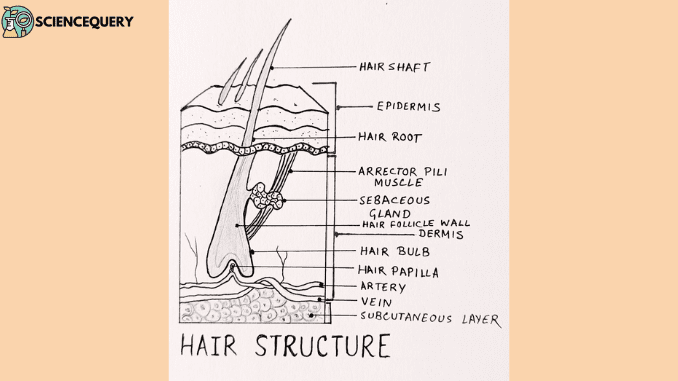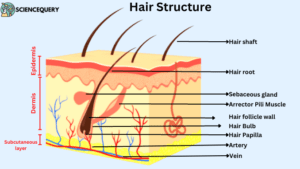
Importance of hair and it’s role
Hair serves a very important function in the human body and plays a crucial role in our overall well-being. In this article, we are going to understand some of the important roles and functions of hair along with the details of the basic hair structure.
- The skin is the largest organ in the human body. Hair is a skin derivative.
- It’s a typical mammalian feature.
- Hair helps in heat preservation and thermoregulation.
- Protects from mechanical damage.
- Helps in sensation.
- Serves as a reservoir of stem cells.
Structure and composition of hair

Hair has two parts, the hair follicle and the hair shaft. Other than this hair is composed of a structural protein keratin. It also contains carbon, oxygen, hydrogen, nitrogen, and sulfur.
- The living and generative part of the hair is known as a hair follicle.
- Whereas the non-living part of the hair is seen above the skin is the hair shaft.
a. Hair follicle
- Encloses the hair root embedded within the dermis.
- The hair root expands to form a hair bulb containing hair papilla with capillary blood supply.
- Upper part of the hair root comprises of infundibulum and isthmus.
- Infundibulum extends from the opening of the sebaceous gland to the surface of the skin; filled with sebum.
- Isthmus lies below the infundibulum and between the opening of the sebaceous gland and the insertion of arrector pilli.
- The lower part contains the supra bulbar region and hair bulb.
- Suprabulbar region lies between the isthmus and the hair bulb. It has three layers
- Outer root sheath containing melanocyte
- The inner root sheath anchors the hair shaft to the hair follicle.
- Hair bulb is the active reproductive portion of the hair follicle.
b. Hair shaft
- The hair shaft is composed of three layers
- Cuticle is the outermost layer, transparent. Formed of tightly packed overlapping keratin cells.
- The cortex lies underneath the cuticle and contains both melanin and keratin. It forms the bulk of the shaft. Determines the texture of the hair.
- Medulla the innermost layer is present in thick coarse hair, otherwise absent.
Hair pigments
The pigment melanin which imparts color to hair is produced by melanocytes.
- Eumelanin when present in large amounts gives black coloration.
- The brown coloration is due to a moderate amount of eumelanin.
- A very small amount of eumelanin causes blonde coloration.
- Pheomelanin gives red coloration to hair.
Hair cycle
Each hair passes through a growth cycle independent of the neighboring hair.
- Anagen phase or growth phase lasts for about three to five years.
- Catagen phase or transitional phase, the hair root separates from the papilla. It lasts from two to three weeks.
- Telogen or shedding phase is when the hair is gradually pushed out of the skin and falls out. It lasts for three to four months.
Hair appendages
The sebaceous gland and the arrector pili muscle are seen associated with the hair.
- Sebaceous glands are lobulated and consist of many sacs that open into a hair follicle by a common duct. The gland’s oily secretion sebum lubricates the hair and makes it soft, supple, and waterproof.
- Arrector muscle of the hair runs obliquely between the hair follicle and the outer part of the dermis. The contraction of this muscle at one end pulls the hair to a vertical position and at the other end, the epidermis gets depressed a condition called goose flesh. It can be experienced during winter.
Factors influencing the hair
- Melanin is the main pigment of the hair. Fluctuations in levels of melanin due to the death of melanocytes, and changes in hormonal levels at all ages influence hair pigmentation. UV radiation and external cosmetic products can cause hair pigmentation.
- The gene responsible for hair color is MC1R.
- Asian population and Native Americans have straight, dark hair.
- Europeans and North Africans have dark to fair, curly, or wavy hair.
- Sub-Saharan Africans have curly, dark, and helically coiled hair.
- Genes influence both hair texture and thickness.
- Curly hair is a dominant gene trait whereas straight hair is a recessive gene trait.
- EDAR gene influences hair follicle development. It also plays an important role in determining hair thickness in the Asian population along with another gene FGFR2.
- Gene TCHH encodes a protein that imparts mechanical strength to the hair follicle’s inner root sheath.
- Defects of this gene cause uncombable hair syndrome.
- The hair shaft diameter of Europeans ranges between 50 to 120 micrometers.
- Asian population has a hair density of about 100 to 130 micrometers.
- The hair shaft diameter of Africans shows a high degree of variation due to its typical helical twists.
- Hair is widely distributed in the human body like at the scalp, pubic, axillary, and phalangeal regions.
- Lanugo hair covers the fetus and is shed before as well as after birth.
- Vellus hair is fine, short, non-pigmented, and covers the body surface of both children and adults. Its diameter is less than 30 micrometers.
- Terminal hairs are coarse being androgen dependent. It’s pigmented, long with a diameter greater than 60 micrometers. It occurs in eyebrows, armpits, and pubic hairs.
- Intermediate hairs have characteristics of both vellus and terminal hairs. It’s found in the arms and legs of adults.
How to care
Scalp hair should be oiled regularly to hydrate and nourish it. Plenty of water intake in the body should be ensured. A healthy and nutritious diet rich in vitamins A, D, and E and minerals zinc and iron improves hair vitality. Skin in and around the hairs should be kept clean, and moist-free. The usage of chemical-laden hair products and heat-styling tools should be avoided.
Common hair related disorders
- ALOPECIA is the loss of hair leading to reduced density of scalp and body hair.
- FOLLICULITIES is an inflammation of hair follicles caused due to infection by bacteria, fungi, or viruses.
- HIRSUTISM is excessive male pattern hair growth in the female body due to hormonal dysfunction.
Q&A
1. What is the structure of the hair?
Hair follicle and hair shaft.
2. What are the three layers of hair structure?
The three layers are the hair shaft, hair root, and hair bulb.
Know in one minute about Hair structure
|
References
The human hair Anatomy to physiology by B. Buffoli, Rinaldi F, et al.
